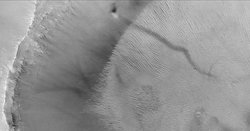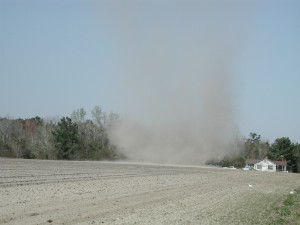Dust devil
|
|
A dust devil is a rotating updraft, 1000 meters high or more and tens of meters in diameter. Dust devils are often observed in times of atmospheric turbulence, especially common in the San Luis Valley of Colorado. They are visible in the Great Basin and eastward to El Paso, for example. They are distinct from the common dust storms of this area, because they resemble small tornados. Due to this they are best viewed from a distance, and at a height (say, from a mountaintop). These whirlwinds are not extremely hazardous to biological organisms, but machines and electronics can suffer many severe malfunctions through repeated exposure to dust devil activity, including but not limited to physical damage or increased wear from dust and short circuits or other physical damage caused by electrical arcing.
It was recently found that even small dust devils (on Earth) can produce radio noise and electrical fields greater than 10,000 volts per meter.[1] (http://www.berkeley.edu/news/media/releases/2002/05/29_dust.html)
In Australia, dust devils are commonly known as willy willies, from an Aboriginal word.
Dust devils also have smaller counterparts by the same name that reach only a few meters or tens of meters in height, forming commonly in hot dry weather, most observably in fields or dusty flats, where the soil makes them visible, and which may be shorter-lived.
You can see a movie of Dust Devils in action at this page: Dust Devil Movie (http://www.animalu.com/pics/dd1.htm)
Mars

Dust devils also occur on Mars, and were first photographed by the Viking orbiters in the 1970s. In 1997, the Mars Pathfinder lander detected a dust devil passing over it.[2] (http://www.ruhr-uni-bochum.de/climusa/dust.htm) Martian dust devils can be up to fifty times as wide and ten times as high as terrestrial dust devils, and large ones may pose a threat to terrestrial technology sent to Mars.[3] (http://unisci.com/stories/20012/0606012.htm)
Mission members monitoring the Spirit rover on Mars reported March 12 2005 that a lucky encounter with a dust devil has cleaned the solar panels of that robot. Power levels have dramatically increased and daily science work is anticipated to be expanded. (space.com) (http://www.space.com/missionlaunches/spirit_dust_050312.html) A similar phenomenon (solar panels mysteriously cleaned of accumulated dust) had previously been observed with the Opportunity rover, and dust devils had also been suspected as the cause. Animations of dust devils moving across the surface of Mars taken by Spirit rover can be found (here) (http://www.jpl.nasa.gov/news/news.cfm?release=2005-061).
External links
- Matador Dust Devil Project (http://www.lpl.arizona.edu/IMP/Matador/)
- Australian Dust Devil Photos (http://www.inflowimages.com/ChaseReports/DustDevils/dustdevils.asp)
- A Dangerous Dust Devil in Japan (video) (http://www.retecool.com/filmpies/stormachtig.html)
- Dust devil imaged by Spirit rover on Mars (http://www.nasa.gov/vision/universe/solarsystem/mer-042105.html)de:Staubteufel

